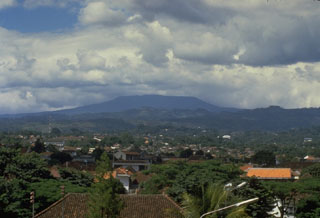Report on Tangkuban Parahu (Indonesia) — 16 October-22 October 2019
Smithsonian Institution / US Geological Survey
Weekly Volcanic Activity Report, 16 October-22 October 2019
Managing Editor: Sally Sennert.
Please cite this report as:
Global Volcanism Program, 2019. Report on Tangkuban Parahu (Indonesia) (Sennert, S, ed.). Weekly Volcanic Activity Report, 16 October-22 October 2019. Smithsonian Institution and US Geological Survey.
Tangkuban Parahu
Indonesia
6.77°S, 107.6°E; summit elev. 2084 m
All times are local (unless otherwise noted)
Diffuse white water-vapor plumes rose 40 m above the vent on Tangkubanparahu's Ratu Crater floor during 14-21 October. PVMBG lowered the Alert Level to 1 (on a scale of 1-4) on 21 October, noting that phreatic events had not been recorded for the past month, deformation data indicated no rising magma, and other data all suggested decreased activity. Tourists were advised to avoid going into the crater.
Geological Summary. Gunung Tangkuban Parahu is a broad stratovolcano overlooking Indonesia's former capital city of Bandung. The volcano was constructed within the 6 x 8 km Pleistocene Sunda caldera, which formed about 190,000 years ago. The volcano's low profile is the subject of legends referring to the mountain of the "upturned boat." The Sunda caldera rim forms a prominent ridge on the western side; elsewhere the rim is largely buried by deposits of the current volcano. The dominantly small phreatic eruptions recorded since the 19th century have originated from several nested craters within an elliptical 1 x 1.5 km summit depression.
Source: Pusat Vulkanologi dan Mitigasi Bencana Geologi (PVMBG, also known as CVGHM)

